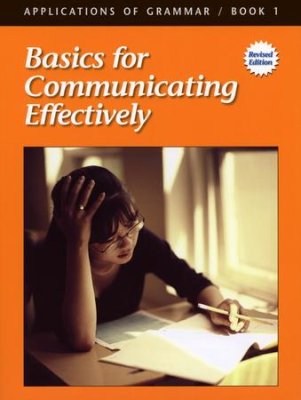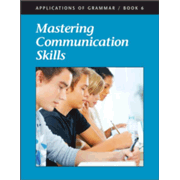Books 1 through 6 in the Applications of Grammar series are designated for grades 7 through 12 respectively, although you might use them at different levels since there are no grade designations. The first two books primarily focus upon grammar (both parts of speech and usage with diagramming). However, increasing attention is given to composition skills as students move through the subsequent levels.
Book 1, subtitled Basics for Communicating Effectively, is quite comprehensive; students with little grammatical knowledge can start here. Instruction begins with the basics, but it continues on through complex concepts appropriate for this level. Complete explanations of concepts are presented with examples so students can work independently. Each lesson is followed by a variety of exercises. Composition instruction focuses mostly upon sentence structure, with paragraph writing addressed fairly briefly in the last section. One 200 to 400-word paragraph is the lengthiest writing assignment in the book, so you will probably want your student to tackle additional writing projects outside of this book. Students will need a good, unabridged dictionary for a number of the lessons in Book 1.
Book 2, subtitled Structure for Communicating Effectively, advances the grammar lessons to topics typically addressed at high school level. This book features very useful charts of grammatical concepts, and grammar rules are numbered so that you might use this as a grammar reference book as you might use Learning Grammar through Writing. I was surprised at the thoroughness of this book. It includes concepts such as conjunctive adverbs and phrases classified according to six different forms, concepts that are not typical for this level. But these are clearly explained with examples and charts when appropriate.
Units in Book 2 cover parts of speech and syntax, phrases, clauses, diagramming, sentence writing (complex structures), vocabulary building (suffixes, prefixes, troublesome words), agreement (noun/verb, pronoun/antecedent, person/ gender, and number), verb conjugations, punctuation, and composition. Composition lessons focus on problem areas rather than organization and structure. Students are given two writing assignments at the end of the book (150 and 200 words each), but, aside from this, they are not doing any significant amount of composition.
Book 3, subtitled Analysis of Effective Communication, is a 336-page, comprehensive text for composition and grammar. It begins with composition skills then moves on to grammar, punctuation, sentence structure, and other mechanical skills. Towards the end are sections on writing a short story, journalism, and developing a more colorful style.
The text is written for students working on their own. There is plenty of explanation with copious examples. However, it might be almost too "wordy" for the student who is not motivated to persevere and work toward better understanding. I would say that the text is ideal for the serious, self-motivated student, but that student will probably find that much of the grammar instruction is redundant. If parents will allow such students to use the text selectively, then it might work very well. For the less-motivated student, I suggest that parents work more closely with them, using the text selectively.
If students have been using serious grammar resources in the elementary grades, they can switch to this series at ninth grade (Book 3), but students with poor backgrounds in grammar will need more coverage of the basics before they can use move into Books 3 and 4.
Book 4, Principles of Effective Communication, continues in the same vein as Book 3 while advancing in difficulty. It devotes entire units to writing a research paper and writing an opinion paper, and it also addresses more general mechanical and stylistic writing skills. Book 4 has been updated to reflect the latest changes in the MLA writing style which is commonly used for research papers and documentation of sources.
Books 1 through 4 are less overwhelming than A Beka's grammar books, but topic coverage is fairly comparable. These tend to offer more explanation and examples than is typical of A Beka's books. Christian content is evident throughout the books from the introduction through most of the lessons, building upon the idea of God as the "origin of language." A glossary and index in each book are helpful for reference. Answer keys are very helpful but test packets are optional.
Books 5 and 6, Developing Communication Skills and Mastering Communication Skills are quite different from the first four books. (The first four have been revised, so these last two books might be revised soon to match the format of the first four books.) These two books are both a bit smaller than the other books. In addition, the print is less dense and in a larger font than Book 4. More importantly, the content is wide-ranging, covering grammar, spelling, vocabulary, and composition. If students have been through moderately challenging grammar and composition programs, these books should work for the final years of high school. However, they seem easier than the first four books in this series.
Grammatical instruction is the strongest aspect of Books 5 and 6; they cover parts of speech and usage at increasingly difficult levels. Most of it is conventional, although the idea of topic sentences having both a topic and a "clew" uses an uncommon definition for clew I don't find in my dictionary. Grammar lessons typically follow the same format: brief instruction, examples, and practice exercises. Diagramming is not taught. Spelling and vocabulary words are presented as lists for students to study on their own. Sometimes a single fill-in-the-blank exercise or writing assignment accompanies a list, but there are no other specific guidelines or activities given. Writing assignments often instruct students to research a topic about which they will write. Instruction for the writing process is minimal, so you should use another resource or other writing activities to better cover the subject. These books are less intensive than A Beka's grammar books, but they do provide good coverage of grammar, and they are very inexpensive. The teacher's editions have answers and occasional teacher notes or explanations that you should share with students. Other than that, students can work through their books on their own. I found nothing distinctively Christian about the content (in contrast to the other books in this series); the books could be used in any traditional school.

















